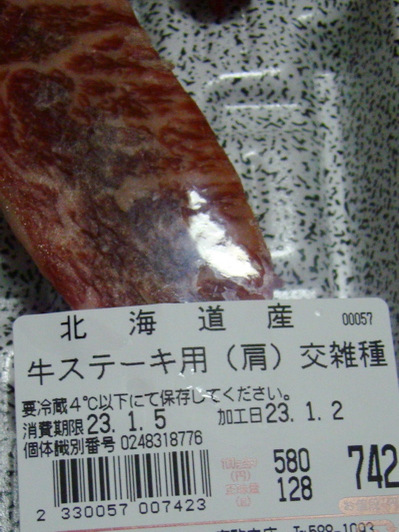Snapshots Japan Meat & traceability 1
So what does the label say?
Meat produced domestically in Japan is pretty expensive, and beef is usually the dearest of all. The label displays all sorts of information, such as the price per 100g (¥580), the weight (128 grammes) and the price of the packet (¥742). Also it states that this cow was raised in Hokkaido, that it’s a piece of steak-grade shoulder meat, and it should be refrigerated below 4 degrees Celsius. It was processed on 2 January 2011 and should be consumed by 5 January 2011. The date format is year — month — date, and the year 23 refers to 2011 being the 23rd year of the Heisei era, which basically is how long the current Emperor has been reigning (now each Emperor’s reign has a single era, but not before the Meiji period).
The 10-digit number (0248318776) can be typed into an online database which shows all you need to know about the cow you’re about to consume. This system of traceability of beef was introduced in the aftermath of the BSE (mad cow disease) scare. Looking up this number, I know that this was a cow (female) born on 1 September 2008 in Mr Sato’s farm. Its father was one of the beef cattle, and its mother a milch cow. It was sold to a company on 18 September 2008, and was raised in this company’s farm until 2 December 2010, the day on which the cow was sent to the abattoir. It was slaughtered and processed into meat on 3 December 2010. Interestingly, it’s when the cow was sent to the abattoir that is listed as the date of processing the meat. Anyway, I’m not entirely sure how access to this kind of information reassures consumers.

